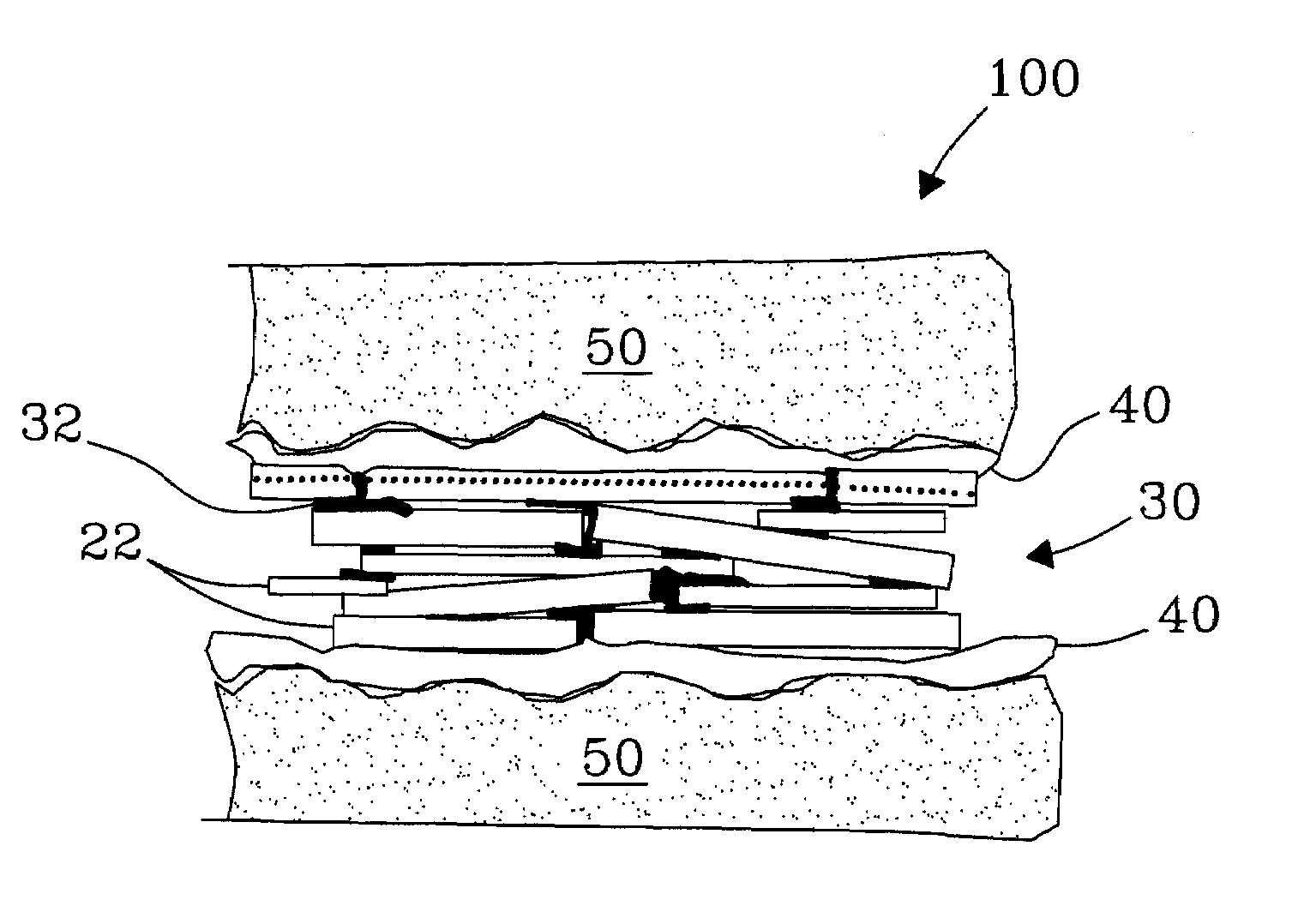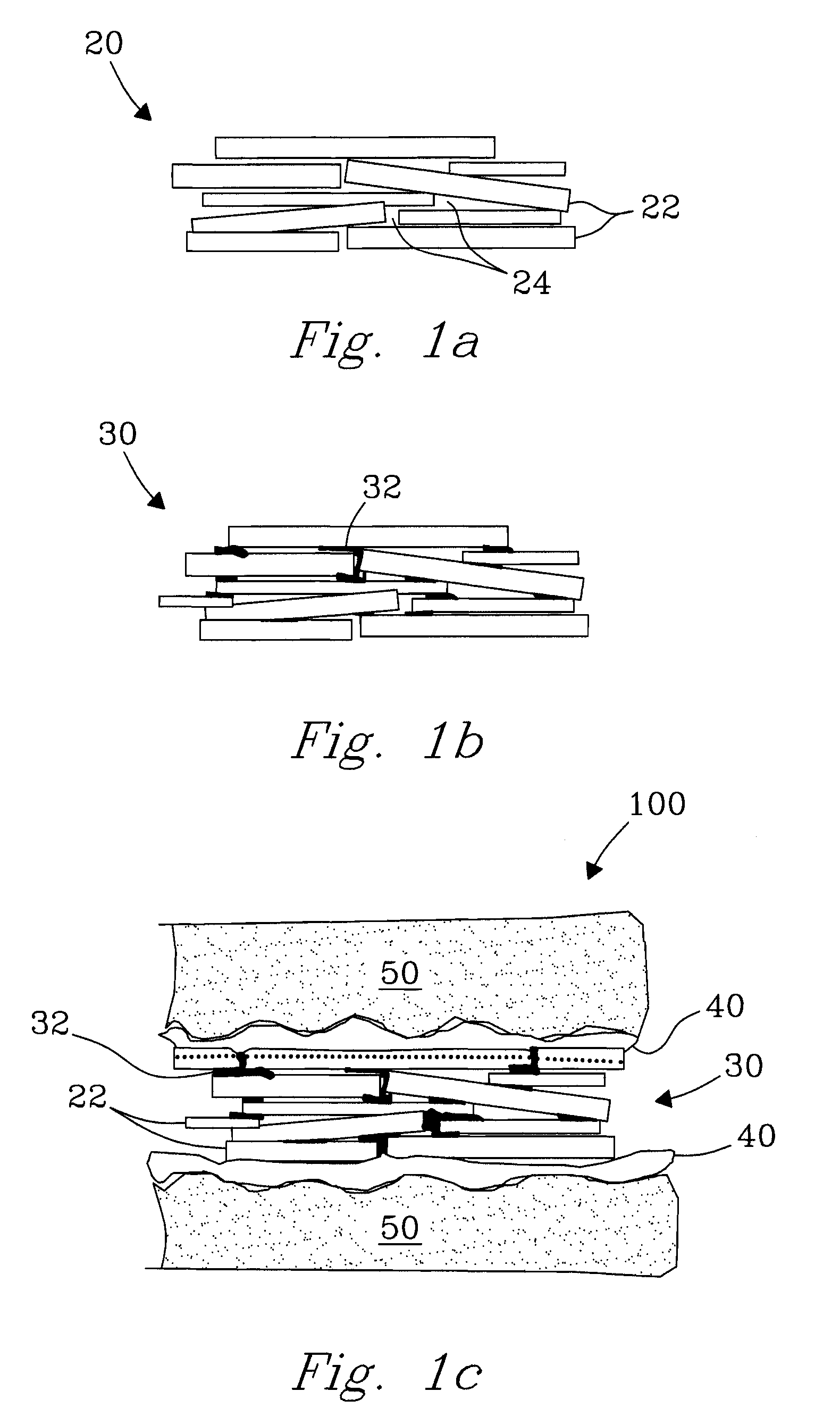Multilayer compressive seal for sealing in high temperature devices
a multi-layer compressive seal and high temperature technology, applied in the direction of cell components, sustainable manufacturing/processing, final product manufacturing, etc., can solve the problems of mica-based compressive seals, device failure, and gas stream mixing with negative consequences, and achieve superior thermal cycling stability and effective low leakage rate
- Summary
- Abstract
- Description
- Claims
- Application Information
AI Technical Summary
Benefits of technology
Problems solved by technology
Method used
Image
Examples
example 1
[0027]In one embodiment, the infiltrated sealing (gasket) member 30 was prepared using a liquid infiltration solution comprising at least one glass or melt forming material. The solid glass former was dissolved in an aqueous liquid to a point of saturation, and subsequently delivered into a plurality of spaces 24 (e.g., voids, interstices, flow paths, leak pathways, etc.) within the matrix of the mica substrate 20 using standard liquid delivery techniques (e.g., pipet). Subsequent drying of the substrate 20 fixes the glass or melt former within the matrix, preparing the infiltrated sealing (gasket) member 30 for use. The sealing member 30 was subsequently leak tested in a simulated multilayer compressive seal (hybrid) 100 under a selected compressive stress in the range from 50 to 100 psi under repeated thermal cycling conditions and at expected operating temperatures up to 850° C., and more preferably in the range from 650° C. to 850° C.
Experimental
[0028]Sample A was heat treated a...
example 2
[0035]In a second embodiment of the present invention, infiltration of the sealing member 30 was conducted as described in Example 1 with the substitution of Bi(NO3)3 in a liquid carrier as the infiltrating liquid, as described hereafter.
Experimental
[0036]The infiltrating liquid was prepared by introducing 20-26 g Bi(NO3)3 solid (98% Bi(NO3)3.5H2O, Alfa Aesar, Ward Hill, Mass.) in 50 mL of de-ionized water at room temperature. Formation of subnitrates (due to a more limited solubility of bismuth nitrate) in the aqueous medium was not found to compromise the beneficial infiltrating properties of the bismuth nitrate. Infiltration was subsequently conducted at room temperature, as described in Example 1. Following infiltration, the sealing member 30 was oven dried at 50° C. for between 0.5 and 1 hour to fix the infiltrating (glass forming) material 32 within the substrate of the sealing member 30. Heating of the bismuth nitrate converts it to the oxide form (Bi2O3) which has a melting ...
example 3
[0039]In yet another embodiment of the present invention, an infiltrated sealing (gasket) member 30 was formed, filled, and sealed with a composite material, a preferred material being a mica-glass (G-18) composite. More specifically, mica flakes 22 or particles 22 ranging in size from a few hundred microns to a few mm were premixed with a glass or melt forming material in a liquid carrier (aqueous or organic solvent(s)). An organic solvent(s) as a liquid carrier was preferred for mixing (e.g., MEK) over the aqueous alternative(s) given the excellent mixing in the composite mixture, the rapid evaporation of the solvent(s), and the faster drying times. Mixing was best effected using a ball-mill or comparable mixer. The sealing (gasket) member 30 was subsequently formed, defined, and / or otherwise applied using standard ceramic processing techniques known to those of ordinary skill in the art. Conventional ceramic processing methods include slip casting, tape casting, tape calendaring,...
PUM
| Property | Measurement | Unit |
|---|---|---|
| operating temperatures | aaaaa | aaaaa |
| operating temperatures | aaaaa | aaaaa |
| temperature | aaaaa | aaaaa |
Abstract
Description
Claims
Application Information
 Login to View More
Login to View More - R&D
- Intellectual Property
- Life Sciences
- Materials
- Tech Scout
- Unparalleled Data Quality
- Higher Quality Content
- 60% Fewer Hallucinations
Browse by: Latest US Patents, China's latest patents, Technical Efficacy Thesaurus, Application Domain, Technology Topic, Popular Technical Reports.
© 2025 PatSnap. All rights reserved.Legal|Privacy policy|Modern Slavery Act Transparency Statement|Sitemap|About US| Contact US: help@patsnap.com



